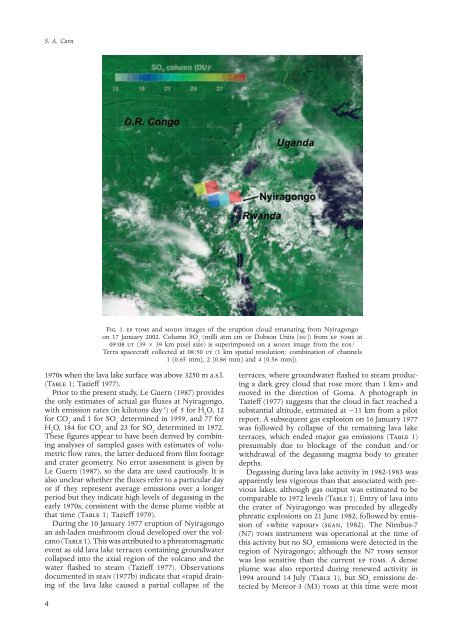eruptive and passive degassing of sulphur dioxide at nyiragongo ...
eruptive and passive degassing of sulphur dioxide at nyiragongo ...
eruptive and passive degassing of sulphur dioxide at nyiragongo ...
Create successful ePaper yourself
Turn your PDF publications into a flip-book with our unique Google optimized e-Paper software.
S. A. CarnFig. 1. ep toms <strong>and</strong> modis images <strong>of</strong> the eruption cloud eman<strong>at</strong>ing from Nyiragongoon 17 January 2002. Column SO 2(milli <strong>at</strong>m cm or Dobson Units [du]) from ep toms <strong>at</strong>09:08 ut (39 × 39 km pixel size) is superimposed on a modis image from the eos/Terra spacecraft collected <strong>at</strong> 08:50 ut (1 km sp<strong>at</strong>ial resolution; combin<strong>at</strong>ion <strong>of</strong> channels1 [0.65 mm], 2 [0.86 mm] <strong>and</strong> 4 [0.56 mm]).1970s when the lava lake surface was above 3250 m a.s.l.(Table 1; Tazieff 1977).Prior to the present study, Le Guern (1987) providesthe only estim<strong>at</strong>es <strong>of</strong> actual gas fluxes <strong>at</strong> Nyiragongo,with emission r<strong>at</strong>es (in kilotons day -1 ) <strong>of</strong> 5 for H 2O, 12for CO 2<strong>and</strong> 1 for SO 2determined in 1959, <strong>and</strong> 77 forH 2O, 184 for CO 2<strong>and</strong> 23 for SO 2determined in 1972.These figures appear to have been derived by combininganalyses <strong>of</strong> sampled gases with estim<strong>at</strong>es <strong>of</strong> volumetricflow r<strong>at</strong>es, the l<strong>at</strong>ter deduced from film footage<strong>and</strong> cr<strong>at</strong>er geometry. No error assessment is given byLe Guern (1987), so the d<strong>at</strong>a are used cautiously. It isalso unclear whether the fluxes refer to a particular dayor if they represent average emissions over a longerperiod but they indic<strong>at</strong>e high levels <strong>of</strong> <strong>degassing</strong> in theearly 1970s, consistent with the dense plume visible <strong>at</strong>th<strong>at</strong> time (Table 1; Tazieff 1979).During the 10 January 1977 eruption <strong>of</strong> Nyiragongoan ash-laden mushroom cloud developed over the volcano(Table 1). This was <strong>at</strong>tributed to a phre<strong>at</strong>omagm<strong>at</strong>icevent as old lava lake terraces containing groundw<strong>at</strong>ercollapsed into the axial region <strong>of</strong> the volcano <strong>and</strong> thew<strong>at</strong>er flashed to steam (Tazieff 1977). Observ<strong>at</strong>ionsdocumented in sean (1977b) indic<strong>at</strong>e th<strong>at</strong> «rapid draining<strong>of</strong> the lava lake caused a partial collapse <strong>of</strong> theterraces, where groundw<strong>at</strong>er flashed to steam producinga dark grey cloud th<strong>at</strong> rose more than 1 km» <strong>and</strong>moved in the direction <strong>of</strong> Goma. A photograph inTazieff (1977) suggests th<strong>at</strong> the cloud in fact reached asubstantial altitude, estim<strong>at</strong>ed <strong>at</strong> ~11 km from a pilotreport. A subsequent gas explosion on 16 January 1977was followed by collapse <strong>of</strong> the remaining lava laketerraces, which ended major gas emissions (Table 1)presumably due to blockage <strong>of</strong> the conduit <strong>and</strong>/orwithdrawal <strong>of</strong> the <strong>degassing</strong> magma body to gre<strong>at</strong>erdepths.Degassing during lava lake activity in 1982-1983 wasapparently less vigorous than th<strong>at</strong> associ<strong>at</strong>ed with previouslakes, although gas output was estim<strong>at</strong>ed to becomparable to 1972 levels (Table 1). Entry <strong>of</strong> lava intothe cr<strong>at</strong>er <strong>of</strong> Nyiragongo was preceded by allegedlyphre<strong>at</strong>ic explosions on 21 June 1982, followed by emission<strong>of</strong> «white vapour» (sean, 1982). The Nimbus-7(N7) toms instrument was oper<strong>at</strong>ional <strong>at</strong> the time <strong>of</strong>this activity but no SO 2emissions were detected in theregion <strong>of</strong> Nyiragongo; although the N7 toms sensorwas less sensitive than the current ep toms. A denseplume was also reported during renewed activity in1994 around 14 July (Table 1), but SO 2emissions detectedby Meteor-3 (M3) toms <strong>at</strong> this time were most4
















